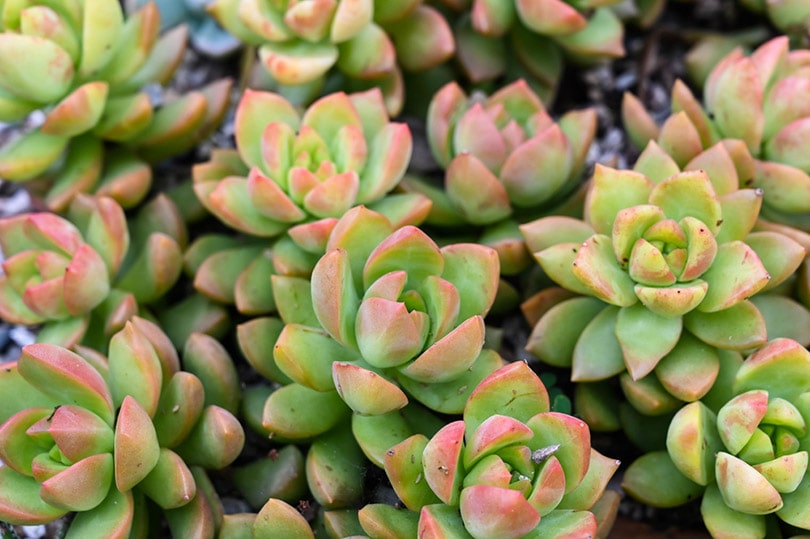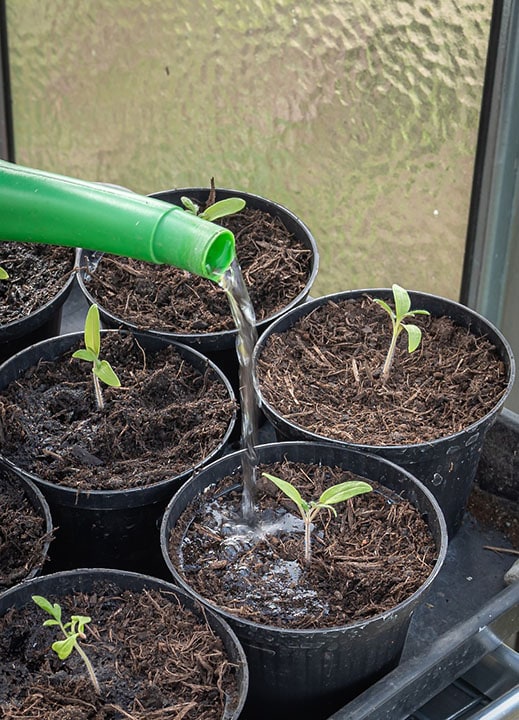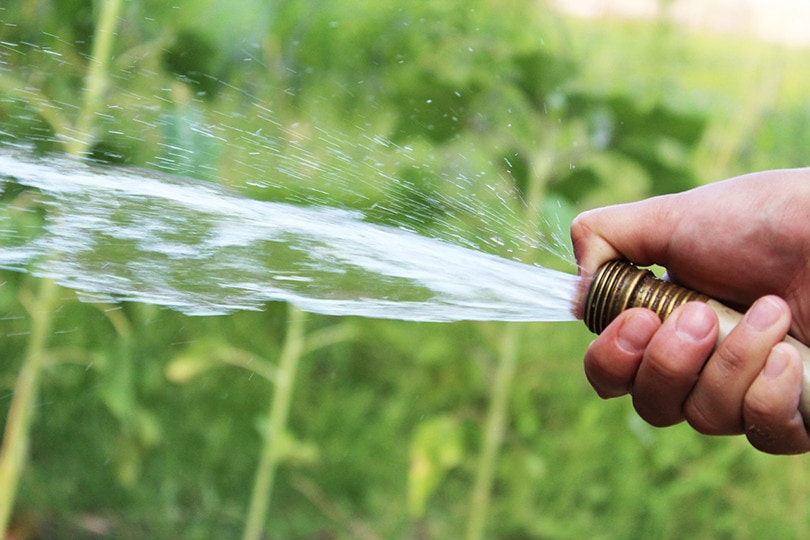How To Propagate Succulents – Tips, Tricks, and Guide
-
Pete Ortiz
- Last updated:

One of the biggest benefits of owning succulents is that they can easily propagate. It’s incredibly simple to multiply a single succulent into a crop of many with very little effort. But if you are like many people who simply snipped off a baby-looking succulent and stuffed it into a pot only to be disappointed when it shriveled and died, you’re not alone. While many succulent owners know that they can propagate, very few people know the proper technique to make it happen effectively.
This guide will cover how to propagate succulents in three different ways. We will cover tips and tricks to ensure that your baby succulents grow over time. By the end, you will feel confident enough to tackle your own succulents. Before you know it, you might have an entire family of succulents created from a single plant.
 What Is Propagation?
What Is Propagation?
The word propagation simply means to grow something from a parent stock. It mainly refers to plants, and it can cover seeds, tubers, cuttings, and buds. Succulents are unique in that they are able to propagate from very small pieces of plant material without having to go through the process of harvesting and planting individual seeds.
Propagation is not something unique to succulents. All plants can propagate. What is unique to succulents is the manner in which they propagate.
Preparation
Before you get started, you will need to gather a few things to ensure that you have what you need for a successful propagation attempt. In order to propagate succulents from parts and pieces, you will need the following items on hand.
- Cactus soil
- New pots
- Tray
- Water/misting bottle
- Sharp garden shears
- Gloves
During your planning, you also need to factor in time. The time for a successful propagation can take up to 6 months to come to fruition. This is not a quick process. Patience will be needed to see a good propagation from start to finish.
Next, choose what type of propagation you are going to pursue. The three methods of succulent propagation are offshoots, leaves, and cuttings. All of these methods have their own
How To Propagate From Offsets
Offsets are tiny or miniature-looking plants that appear at the base or attached to your succulent. These can be harvested and propagated very easily in just a few steps.
- High success rate
- Fastest method
- Easy to see important details
- Can be difficult to separate from the parent
1. Separate Roots
First, if the plant has created roots of its own, you will need to gently separate the roots. If the succulent is growing alone in a pot, the easiest way to do this is to remove the succulent as though you are going to repot the plant. Sift through the roots and separate the offshoot as best you can from the parent plant.
2. Gently Remove Mini Plant

Once the roots are separated, gently pull the plant away from the parent. If the offshoot is attached to the parent plant, you can use a pair of garden shears or a razor blade to carefully cut it away. Once the offshoot is separated, set it aside. If the offshoot already has roots, it is ready for the next step. If the offshoot does not have evidence of roots, then it needs to be set aside until new roots appear. That can take anywhere from 2 weeks to 2 months, depending on the age of the offshoot.
3. Replant and Water
Once the roots are showing, the offshoot is ready to be replanted. Put it into a pot with cactus soil and gently press it into the dirt. Give it one good watering to start, and then monitor it for signs of dryness for the next few weeks. A healthy offshoot with good roots is the easiest way to get a succulent to propagate.
How To Propagate Succulents From Leaves
One of the most impressive things that succulents can do is propagate from a single leaf. It is possible to get a brand new succulent from one leaf, but it is not easy to accomplish.
- Very satisfying to pull off
- Leaves are abundant
- Low success rate
- Hard to see the callous and the roots on a small leaf
1. Gently Pull Off a Healthy Leaf
The best chance for success with a leaf is to choose a large and healthy leaf for propagation. Try not to take more than one or two really good leaves because plucking a succulent of its best leaves can hurt the parent. Gently take the leaf in two fingers and pull from the base until the leaf comes off. If you want, you can also try cutting the leaves off with garden shears.
Try not to damage the leaf during this process.
2. Lay Them Out To Dry
Next, lay out the leaves to dry on a tray in the sun. Some people put their leaves on soil or in the sand to simulate desert conditions. The leaves need to be kept dry and in the sun in order for them to begin the propagation process.
3. Wait For Roots To Sprout
It can take a few weeks, but eventually, roots will sprout from a good leaf. During this process, your leaves might start shriveling and turning brown. This is normal. The leaf will start to feed itself to the new propagation growing in the base. When the roots sprout the leaf will often look like it is dying. Do not be alarmed.
4. Replant and Water

Once the leaf has roots, it can be replanted in its own pot. Start with a small pot and put the leaf in roots down into the soil. Gently press it in and water it. Do not overwater it. If you need to support the old leaf, put something in the pot to help hold it up until it is mature enough to stand on its own. Now you just have to wait for the new succulent to start budding out from the base of the old leaf. You will know when a tiny succulent begins to emerge from the base.
How To Propagate From Succulent Cuttings
Cuttings are pieces of a plant cut off from the stem that can be turned into a new succulent. Cuttings are fairly simple to achieve success with if you choose the right parts.
- Good success rate
- Straightforward
- Need the right length stems
- Bad cuts can hurt the parent and lead to failure
1. Choose The Right Stem
The best stems for propagation have multiple leaves already on them with 3 inches of bare stem to work with. In a pinch, a section with just 1 inch of the clear stem will do but 3 inches is ideal. If you do not have any stems with a lot of bare space then you should wait until your succulent grows a little more.
2. Cut The Section
Next, using sharp garden shears, cut the section that you want to plant. Again, try to cut below the 3-inch mark. An ideal cutting will have a cluster of healthy leaves at the top and 3 inches of stem below. Do not cut the stem too short, and do not damage the leaves during the process.
3. Lay Out Cuttings
After you have your section (or sections if you are doing multiple), it is time to lay them out to dry. Many people simply lay them out on a garden tray or set them on their sides on top of a pot with soil in it but no plants. You want the cuttings to get good sunlight and not get too wet. The cuttings need to be left alone to dry in order to be successful.
4. Wait For Callouses
It can take weeks for callouses to appear, but that is an important part of the process. The bottom of your cuttings will slowly develop a knotty growth that appears and seals off the stem from the outside. Once the callous appears, you will know that the cutting is progressing in the propagation process.
5. Water

After the callous appears, you should lightly water the cuttings. Some people suggest misting the cuttings. Do not let the cuttings sit in water. Just give the callous areas a little bit of liquid to get moist.
6. Wait For Roots
If everything goes well, roots should appear after the callous. The roots will emerge from the callous, and they should be small and translucent. When they appear, they will be short so keep a close eye out. It can take another few weeks for good roots to appear from the cuttings. After you are sure that the roots are coming in, you can move on to the next step.
7. Replant and Water

Roots mean that it is time to plant. Take your cutting and place it in cactus soil roots down. Gently press it into the soil and water it in. If the cutting is long and unable to support itself, it might be a good idea to add a stick to help it stand up. Keep an eye on the plant to watch for signs of root rot or browning for the first couple of weeks after planting.
How Long Do Succulents Take To Propagate?
The time for each individual succulent to propagate varies. The minimum amount of time it will take to go from a cutting to a baby plant will be a month. Most plants take 3 months to establish a solid pup that is likely to survive. Going from a single leaf cutting to a fully grown plant can take 6 months or longer. While succulents are amazing plants, they are not magical. These things take time.
If you plan on propagating any of your succulents, plan on investing at least 3 months for good results and understand that it may take even longer than that.
What Succulents Can Propagate?
Nearly every species of succulent and small cactus can propagate through cuttings, buds, or leaves. It is a defining feature of this type of plant. If you have any questions about whether or not your specific succulent can propagate in these ways, try and find the scientific name to look it up or ask your local extension office for guidance.
Generally, every succulent you can find at your local stores should be able to propagate through cuttings, leaves, or offshoots.
Do Not Neglect New Succulents
Succulents are known for being extremely hardy and durable plants that require very little maintenance. However, baby succulents need more attention than full-grown plants. If you treat your newly sprouted succulent buds like you do the mature adults, you could accidentally kill them. Baby succulents need a little more water than adult succulents (but still not too much), and they will benefit from some light feeding and fertilizer. They make special cactus and succulent foods that you can buy at your local garden center for just that purpose.
Do Not Plant Too Soon
One of the biggest mistakes that people make when trying to grow new succulents from cuttings or leaves is trying to plant them too soon. Many people simply take a leaf and try and stuff it straight into the dirt, and that simply won’t work. You have to lay out the leaves and let them dry, callous, and then root. Once the roots appear, you can plant them in their first pot. If you try and plant your succulent parts before they are ready, they won’t grow.
The reason you have to lay out the leaves and cuttings and wait for them to dry and then grow roots is that you are trying to replicate what happens in the desert. When succulents reproduce in the wild, they do not drop leaves into fully formed pots ready to go. Wild succulents drop leaves which eventually mature to the point where they are ready to take root. But the process takes time. Don’t rush it.
Keep Trying
If your first propagation attempts do not go well, do not give up. It can take a few tries to get good cuttings and leaves that are ready to grow. Just like in nature, not every seedling will be successful. Propagation can take a couple of tries to get right. Propagating succulents from offshoots or buds that appear on or next to an adult succulent gives you the best chance of success. Trying to propagate from a single leaf is the hardest method with the lowest chance of success. Choosing what method of propagation to go with can drastically influence your chances for success the first time.
Conclusion
Once you learn the ins and outs of the practice, you will be able to grow fresh succulents regularly. These tips and tricks will give you the knowledge to pursue your own propagation attempts. Following these steps and keeping an eye out for the important signs along the way can greatly improve your chances of a successful propagation effort. The first sight of tiny succulent leaves breaking through is worth the effort and the wait.
Featured Image Credit: Beate Panosch, Shutterstock
Contents

 What Is Propagation?
What Is Propagation?